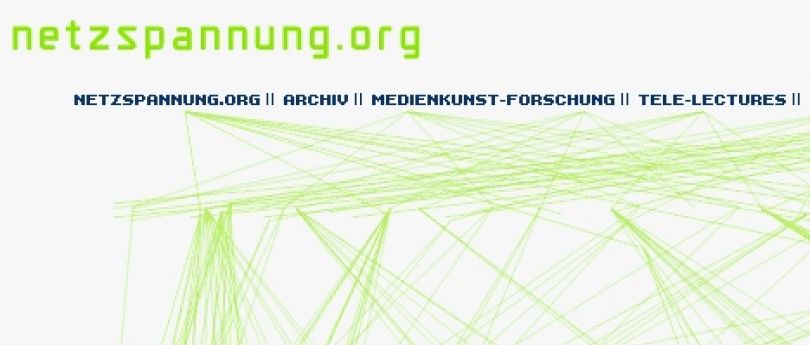Kennis /
Archive 2020: Netzspannung.org

Netzspannung.org Screenshot
— An Internet platform for artistic production, media projects, and intermedia research.
onika Fleischmann and Wolfgang Strauss, at the Fraunhofer IAIS - MARS Exploratory Media Lab
Netzspannung.org
netzspannung.org
is an Internet platform for artistic production, media projects, and
intermedia research. As an interface between media art, media technology
and society, it functions as an information pool for artists,
designers, computer scientists and cultural scientists. Headed by Monika
Fleischmann and Wolfgang Strauss, at the MARS Exploratory Media Lab,
interdisciplinary teams of architects, artists, designers, computer
scientists, art and media scientists are developing and producing tools
and interfaces, artistic projects and events at the interface between
art and research. All developments and productions are realised in the
context of national and international projects. See this video for more information.
Generating, Conveying and Appropriating Knowledge
netzspannung.org
is a knowledge space. This means that alongside developing an
extensive, up-to-date archive, the focus is on creating different
avenues for exploring the media art field. For this purpose
netzspannung.org provides services and tools that help users process
information more easily and can be used for generating, conveying and
appropriating knowledge. The full range of content, services and tools
is available to users free of charge.
netzspannung.org's databases
A central component of netzspannung.org is its publicly accessible archive. This comprises numerous works of media art, projects from IT research, and lectures on media theory as well as on aesthetics and art history, all in the form of text, image and video presentations. The archive also contains content processed by the editorial team as well as community contributions. netzspannung.org firmly believes that contextualization and visualization are crucial factors in the discovery and acquisition of knowledge. This is why the archive interfaces provide alternative accesses to netzspannung.org's database.
Classic View
The
classic view interface presents the database's contents in list form.
Here visual information is a significant element, supporting visual
access to the contents of the database. These contents (project
descriptions, events, articles) can be arranged and sorted according to
different criteria.
Archive Browser
The archive
browser provides an overview of all the database's contents. They are
organized in different categories (people, subject matter, keywords,
latest additions), are combined into indexes, and presented in
alphabetical lists. Thus the user can, for example, obtain an overview
of all the people featured in the archive or look through the database's
contents grouped by keyword.
Randomizer
The
randomizer interface automatically generates with each loading process a
random selection of 30 images, each of which refers to an entry in the
database. It offers a purely visual and intuitive access to the archive.
Semantic Map
The
semantic map presents the archive in an overview map, structuring and
visualizing netzspannung.org's database entries according to semantic
criteria. The semantic map provides new possibilities for discovering
semantic connections between content from different disciplines. Because
the interface is based on a text analysis, German and English texts are
each provided with a map of their own. The contents of the two maps are
different because many database entries are only available in one
language.
Media Flow Browser
The Media Flow transmits
an immediate impression of the documents in the online archive. Access
is based on image or text. The flow of words indicates keywords, authors
and titles of the documents. By choice of words or images, the relevant
document is visually highlighted. Selecting one shows the data in
context. Using text-to-speech processing the visual impression is
augmented by artificial voices. The Media Flow interface creates an
atmospheric image and sound domain. The floating interface supports the
user to find things he or she would normally never discover. Therefore
the Media Flow is an alternating interface to browse the
netzspannung.org archive.
Biographies
Monika Fleischmann
Monika
Fleischmann, born 1950, German research artist, studied visual arts,
theater and computer graphics. Since 1992 she has been artistic director
of the Institute for Media Communication; since 1997 she has been head
of the MARS exploratory media lab at (the Fraunhofer Institute for Media
Communication since 2005 the) Fraunhofer Institute Fraunhofer Institute
for Intelligent Analysis and Information Systems IAIS in Sankt Augustin
near Bonn. In 1999 she started - together with Giaco Schiesser and the
Knowbotic Research group - a New Media Department at the University for
Art & Design in Zürich. In 1988 she was co-founder of Art + Com,
Berlin, a research institute for computer-assisted media art,
architecture, design.
Wolfgang Strauss
Wolfgang
Strauss, born 1951, is architect, media artist and scientist. He works
with old and new media and creates real buildings as well as electronic
architecture, knowledge spaces and digital archives. He is head of the
R&D activities on human-machine communication at the MARS –
Explorative Media Lab of Fraunhofer Institute Intelligent Analysis and
Informationsystems IAIS. His second area of competence is in knowledge
arts and media. In 2000 the internetplatform „netzspannung.org“ was a
forerunner of Web 2.0 cultural techniques like Wikis and Blogs. The
platform is directed to the media arts & technology community
dealing with archiving and examining user generated content. Since 1987,
he has produced a large number of media art and design works on the
topics of mixed reality, networked information space and the
visualisation of knowledge in cooperation with Monika Fleischmann. He
studied Architecture at the Hochschule der Kuenste (University of Arts)
in Berlin, has worked as guest professor, has had fellowships and has
given numerous talks in Germany and abroad. In 1992 he was awarded with
Ars Electronica’s Golden Nica for interactive art. In 2005 and 2007 he
received the if-communication design award.
Netzspannung.org is a case study presented during Archive 2020.
